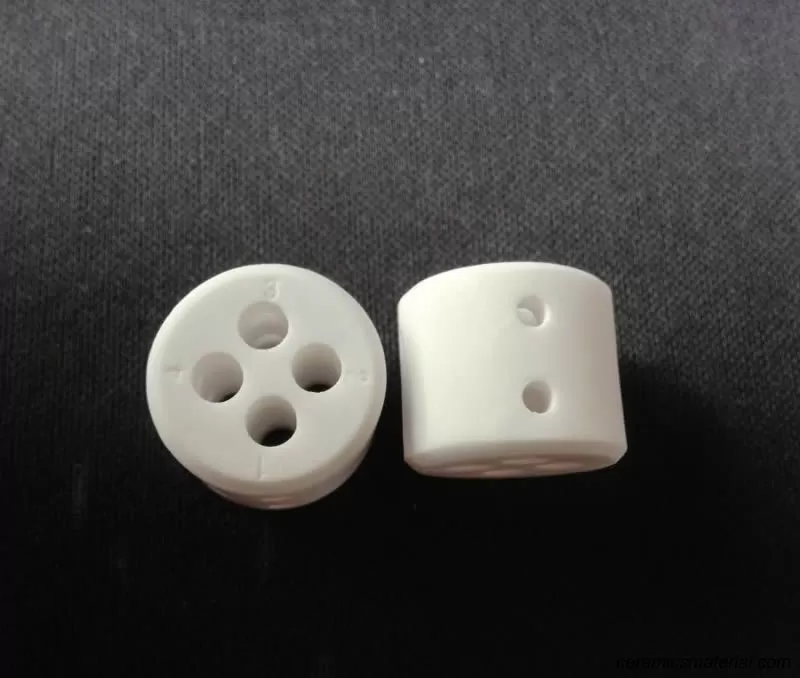Introduction and application of alumina precision ceramics
1.Introduction to alumina precision ceramics
Alumina precision ceramic is a ceramic material with α-Al2O3 as the main crystal phase. The Al2O3 content is generally between 75% and 99.9%. Usually classified by the Al2O3 content in the ingredients. Porcelain with a content of about 75% is called "75" porcelain, content of 85% is called "85" porcelain, content of 95% is called "95" porcelain, and content of 99% is called "99" porcelain.

2.Alumina precision ceramic manufacturing
The production process of Al2O3 porcelain is also different due to different product performance requirements, different formulas, different shapes and sizes, and different molding methods. The basic process is: calcining of raw materials, grinding, shaping, and sintering.
a.Calcination
The purpose of calcination is to transform γ-Al2O3 into α-Al2O3 and to eliminate low-melting point volatiles such as Na2O in the raw materials.
b. Grind finely
The calcined Al2O3 needs to be ground finely, and the fineness of Al2O3 has a great impact on product performance. Generally, particles smaller than 1 μm are required to account for 15% to 30%. If it is larger than 40%, severe grain growth will occur during sintering. When particles larger than 5 μm are larger than 10% to 15%, sintering will be significantly hindered. The ball milling process can be used for wet grinding or dry grinding. When dry grinding, 1% to 3% of admixtures are added, such as oleic acid, etc. It can prevent particles from sticking and improve ball milling efficiency.
c. Molding
Various methods such as grouting, molding, hot die casting, hot pressing and isostatic pressing can be used.
d. Sintering
The sintering system has a great impact on the density and structure of Al2O3 porcelain, which also affects the performance of the product. For Al2O3 porcelain, sintering is generally carried out under conditions below the temperature limit and the holding time is appropriately extended.
3. Properties and applications of alumina precision ceramics
Al2O3 porcelain has a wide range of uses. Depending on the content of Al2O3, its properties are different and its uses are also different.
a. High mechanical strength
The flexural strength of Al2O3 porcelain sintered products can reach 250MPa, and the hot-pressed products can reach 500MPa. The purer the Al2O3 component, the higher the strength. The strength can be maintained up to 900°C at high temperatures. Using the mechanical strength of Al2O3 porcelain, device porcelain and other mechanical components can be made.
b. High resistivity and good electrical insulation properties
The resistivity at room temperature is 1015Ω·cm, and the insulation strength is 15kV/mm. Using its insulation and strength, it can be made into substrates, tube base spark plugs, circuit casings, etc.
c.High hardness
With a Mohs hardness of 9 and excellent wear resistance, it is widely used in the manufacture of cutting tools, grinding wheels, abrasives, drawing dies, extrusion dies, bearings, etc. When using Al2O3 ceramic cutting tools to process automotive engine and aircraft parts, high precision can be obtained at high cutting speeds.
d. High melting point and corrosion resistance
The melting point is 2050°C, and it has good resistance to the erosion of molten metals such as Be, Sr, Ni, Al, Fe, Ta, and Mn. It also has high resistance to corrosion by NaOH, glass and slag. It does not interact with Si, Sb, and Bi in an inert atmosphere. Therefore, it can be used as refractory materials, furnace tubes, glass drawing crucibles, hollow balls, fibers, thermocouple protective sleeves, etc.
e.Excellent chemical stability
Many complex sulfides, phosphides, arsenides, chlorides, nitrogen compounds, bromides, iodides, oxides, as well as sulfuric acid, hydrochloric acid, nitric acid, and hydrofluoric acid do not interact with Al2O3. Therefore, Al2O3 can be made into pure metal and single crystal growth crucibles, human joints, artificial bones, etc.
f. Optical properties
It can be made into light-transmitting materials (transparent Al2O3 porcelain) and used to make sodium vapor lamp tubes, microwave fairings, infrared windows, laser oscillation components, etc.
g. Ionic conductivity
Used as solar cell materials and battery materials.
Share the Introduction and application of alumina precision ceramics
Recent News
- Introduction to the manufacturing process and application ma...
- Introduction and application of 95 alumina precision ceramic...
- Introduction to the characteristics, processes, and applicat...
- Diversified applications of precision ceramic materials: fro...
- Comparing precision ceramic cleavers, diamond knives, and me...
- Advantages of precision ceramic dispensing valves compared t...
- What are the advantages of precision ceramic valves compared...
- What precision components can be made from precision ceramic...

